
by admin | Jun 30, 2013 | River Road
There is no shortage of scenic roads in this state, including many portions of Louisiana Highway 1. The longest road in the state, it runs from Grand Isle to north of Shreveport. We tackled a small portion of it last weekend, driving from Donaldsonville to Port Allen up the westbank of the Mississippi River before crossing over to end at Baton Rouge.
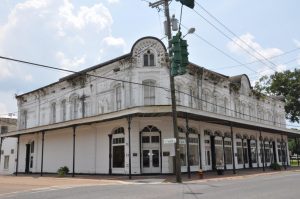 |
| Former Department Store, B. Lemann & Bro. building, in Donaldsonville |
Just a short distance from the Sunshine Bridge, Donaldsonville stands as the parish seat of Ascension Parish and a former capitol of the state of Louisiana (back in 1830). The town’s population and importance in history have fluctuated over the years, as evidenced by the vine-covered ruins of homes just off the main roads of Louisiana’s second largest historic district. Yet, the downtown streets are lined with impressive buildings that testify to this town’s importance and prosperity in the 1800s, long before the industrial plants entered the scene of this agricultural economy.
Many of the buildings are maintained today, such as the red brick courthouse and the one-time department store B. Lemann & Bro. building, both designed by architect James Freret. My particular favorites were the elk-adorned Italianate Elks Lodge and the “For Sale” Bel House, which looked like it was plucked right out of New Orleans’ French Quarter. Donaldsonville also lays claim to primitive artist Alvin Batiste.
 |
| Nottoway Plantation |
From here, we continued north toward Iberville Parish and the town of White Castle, famous for the south’s largest plantation resort – Nottoway Plantation. With 64 rooms and 53,000 square feet within the walls of this massive palace, Nottoway is best seen from River Road, where its white-columned front faces the Mississippi River. Built in 1859, this plantation was a modern marvel for its day, boasting running water in the bathrooms and gas lighting throughout the home’s interior. Today, the plantation has indeed become a resort, with a Grand Pavilion, a Mansion Restaurant, outdoor pool and cabana, and tennis courts. On the day we visited, tents were pitched throughout the property and RV’s lined the outer edges of the parking lot. We hadn’t passed a soul on River Road, yet Nottoway was swarming with people – certainly a hot attraction for the area.
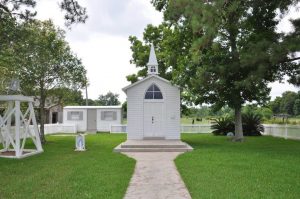 |
| Madonna Chapel |
In sharp contrast to Nottoway, the world’s smallest church resides just up the road in Bayou Goula. The tiny, one-room Madonna Chapel is sandwiched between a new house and a field of grazing cattle. We initially passed the site and, after turning around, pulled off the edge of River Road to make our own parking space. The kids bolted in the white picket fence in search of the hidden key to unlock the chapel. It wasn’t really “hidden,” only tucked away inside a box labeled “key,” but seeing as neither of them can read yet, they had quite the scavenger hunt.
The chapel was stifling hot inside, and we left the door open wide as we gazed at the small altar covered in statues of Jesus and Mary and read its touching story. Only eight feet square, the chapel was built in 1903 by a farmer, Anthony Gullo, who promised to build a church to the Madonna if she helped his oldest son recover from a serious illness. An annual mass is held here on August 15 in celebration of the Assumption of the Blessed Mother.
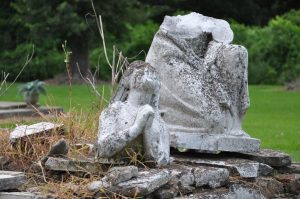 |
| St. Raphael Cemetery |
Our next stop was St. Raphael Cemetery, a crumbling grouping of graves and monuments laid out in the bend of the river across the Mississippi from St. Gabriel. Aside from the interesting architecture of the tombs, this is also the final resting spot for Louisiana’s 15th governor, Paul Octave Hebert.
River Road reconnected with Highway 1 in Plaquemine. A summer thunderstorm was rolling in as we pulled up to the Plaquemine Lock State Historic Site, and the skies opened up the moment we entered the lockhouse. The friendly, knowledgeable state park guide welcomed us to the museum and seemed to cater to our every need. Our two-year-old, August, was mesmerized by the working scale model of the lock system, anxiously watching the tiny lock doors open and the boat slowly make its way inside the lock. My husband grabbed a complimentary coffee and headed up the winding staircase for pristine views of the Mississippi River.
 |
| Plaquemine Lock State Historic Site |
As the rain stormed on, the ranger started a funny movie about singing fish to entertain the kids so we were free to browse the exhibits. We discovered the lock was built between 1895 and 1909 to connect the river with Bayou Plaquemine and was designed by Col. Goethals, who later became chief engineer of the Panama Canal. It operated for 52 years until shutting down when a larger lock was built in Port Allen.
When we ventured outside again to view the structure itself, my five-year-old, Charles, spotted an oversized beetle hiding in the doorjamb. Our host then pointed out an even larger beetle (scarily large) that thrilled Charles for the rest of the weekend. He made the bug a home in a coffee cup and carried him all over the property, from our walk up the levee to our stroll across the lock bridge and far below to the lovely waterfront boardwalk. After we (and the bugs) finished our journey, we drove the streets of Plaquemine, gazing at the historic homes and the St. John the Evangelist Catholic Church, “The Cathedral on the Bayou.”
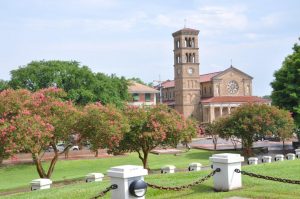 |
| St. John the Evangelist in Plaquemine |
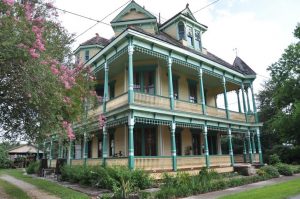 |
| Historic Home in Plaquemine |

by admin | Jun 18, 2013 | Featured Posts, Greater New Orleans
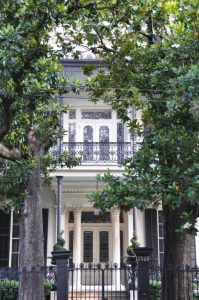 |
| Another Garden District Beauty |
In the midst of t-ball and swim lessons, we’ve been sticking close to home as of late, taking short adventures in and around New Orleans. Our latest outing was something we rarely do, a guided walking tour of one of the most extravagant sections of the city – the Garden District. Once home to wealthy Americans looking to settle outside of the French Quarter, today many of the area’s mansions boast historic signs detailing fascinating stories that often end with links to Hollywood stars.
We met our guide, Kevin from NOLA Native Tours, on Magazine Street at the Defend New Orleans store. The early morning weather was clear with a cool breeze that made the shaded sidewalks comfortable on this mid-summer day. Kevin led us north on 1st Street, deep into the heart of the quiet neighborhood. Aside from the occasional dog-walker, we had the street to ourselves, with no one watching us gawk at the beautiful homes before us.
In the early 1800s, this area was known as the city of Lafayette, eventually annexed by the city of New Orleans in 1852. Our tour guide pointed out notable architecture styles, from Victorian to Italianate and Greek Revival, all with varying degrees of cast iron railings and flickering Bevelo gas lanterns. I was particularly fascinated by the large marble slab lying by the curb in front of one of the homes. I never would have guessed it was once used as a step for ladies exiting carriages, a fact that so easily painted an imaginary scene of well-dressed revelers arriving in their carriage for an evening party.
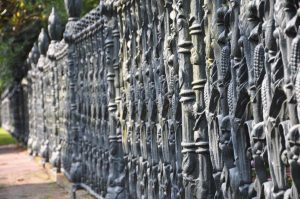 |
| Cornstalk Fence |
We passed the home where Jefferson Davis, the first and only president of the Confederacy, died. Nearby, vampire-author Anne Rice grew up in the Brevard-Rice house, just a few steps away from the Mannings’ mansion (yes, that would be the Mannings…football icons Archie, Peyton and Eli). On Prytania, the French flag waved in front of the French Consulate, while across the street, a rectory once built for Redemptorist priests later became another possession of Anne Rice and then actor Nicholas Cage. Meanwhile, an intricate cornstalk fence surrounded one grand home, proving that the famous fence does exist outside of the French Quarter.
The tour paused at the Rink, a collection of boutique stores, the Garden District Book Shop and a coffee shop, before unleashing us inside Lafayette Cemetery Number 1. We spent nearly half an hour here, photographing the elaborate above-ground tombs with springy plants emerging from their crevices. This city of dead is crowded and slightly crumbling, details that somehow make it even more alluring.
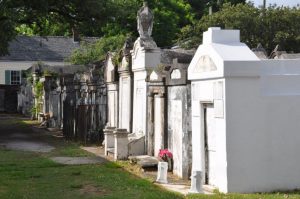 |
| Lafayette Cemetery |
The last stretch of our journey showcased one of the city’s best-known restaurants – Commander’s Palace, and exquisite homes perhaps more famous for their architecture than for their Hollywood owners (Sandra Bullock and John Goodman). It was a pleasant walk in the hands of a knowledgeable tour guide, one who casually turned a morning stroll into an exploration of beauty, time and entertainment.
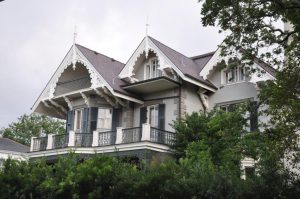 |
| Sandra Bullock’s Garden District Home |

by admin | Jun 4, 2013 | Greater New Orleans
On a coveted three day holiday weekend, t-ball and birthday parties kept us tied to the city, so we used the extra day to explore our hometown. It’s so easy to settle into work and school routines during the week, and take off exploring the unique small towns and parishes on our days off. Yet, I also find that we often forget how interesting our own city of New Orleans is, so we donned our tourist hats and headed to the French Quarter.
Being a local has a few perks, such as knowing to park at the foot of Canal Street at the Shops at Canal Place. We spent five minutes buying the kids a muffin at Starbucks, and then immediately took our parking ticket to the Concierge to be validated (a nice savings in parking fees). Another perk was catching half-price tickets to the paddlewheeler Creole Queen on Travelzoo – all the motivation we needed to try out the river cruise.
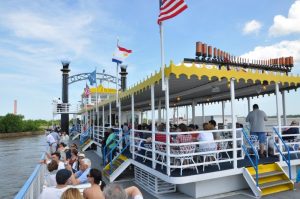 |
| Aboard the Creole Queen |
We walked the short distance to the boat’s dock and secured our tickets for the daily excursion. The line to board was already wrapped around the side of the Riverwalk, and with one glance at the kids, we knew they were not going to wait. So we instead strolled along the river, watching the massive ships go to and from the busiest port complex in the world. We returned as the last of the passengers took their group photo and passed through security. The downside of waiting to the end was no more available seats on the ship’s deck, but seeing as our two- and five-year-old rarely sit for long, it wasn’t that big of a deal.
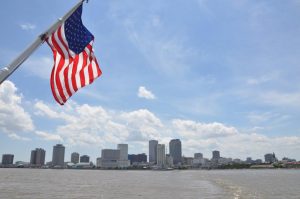 |
| View of the city from the Creole Queen |
We watched as they unwound the ropes holding the boat to the dock and started up the paddlewheel, slowly propelling us out into the middle of the river. Inside people were lining up for hot food and cold drinks, while we toured the boat, investigating the view from every floor and side. A narrator pointed out memorable locations, and the kids discovered hiding places under overhanging decks and built-in “slides” next to indoor stairways. We relished in the breeze counteracting the hot sun, and hid in the shadows when we needed a break. Before long, we passed the Bywater, the Industrial Canal and the Louisiana National Guard’s headquarters at Jackson Barracks on our way south to Chalmette Battlefield in St. Bernard Parish.
As many times as we’ve walked the grounds and toured the home at this National Historical Park, we
 |
| Musket firing demonstrations at Chalmette Battlefield |
had never arrived via the river and never visited on a day when costumed living historians had set up camp on the property. We learned how young ladies looked “graceful” while playing games, explored a tent and common items carried by 1815 soldiers and watched musket firing demonstrations that had our youngest shouting “No!” at the volunteers. Meanwhile, our oldest, Charles, was anxiously listening for the one long and two short whistles that would signal our five minutes to reboard. As soon as they blew, he took off running toward the boat, warning us he would leave us behind if we didn’t make it back in time.
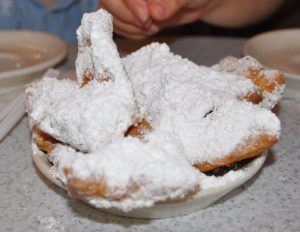 |
| Cafe du Monde beignets |
The kids were tired when we finally arrived back at port, so we popped them in the strollers and let them relax as we walked along the river down into the heart of the Quarter to Cafe du Monde. Once again, the line for outdoor seating was stretched far out beyond the famous cafe, but we strolled right past them and entered the air conditioned indoor area and grabbed one of several empty tables. Here, we re-energized with cafe au lait, and the kids perked up with a great deal of powdered sugar on top of their beignets. You could sense the sugar settling into their system, sending jolts of energy through every inch of their tiny bodies.
 |
| Andrew Jackson in Jackson Square |
Rearing to go, we crossed the street to Jackson Square, greeting the mules lined up waiting to lead
buggy tours. While August “neighed” at them, Charles spotted a balloon man and scored them both balloon swords, which came in quite handy for the sword fight that ensued around the statue of Andrew Jackson. The Quarter was alive with music and street performers, brass bands and cheering crowds. A wedding party paused to snap photos outside St. Louis Cathedral before the bride took a deep breath and entered the church doors. We took it all in for a while, venturing around back of the Cathedral to investigate the artists there and savoring the vibrancy for which New Orleans is known.
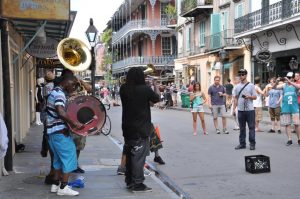 |
| Musicians on Royal Street |
When the musicians paused, we took our cue and headed up Chartres to the Napoleon House for a dinner of shrimp remoulade and red beans and rice for the kids. Paul and I topped it off with a Pimms Cup, a light, summer drink, and reminisced about our own wedding reception held upstairs here more than 10 years ago. Built in 1797, the house was offered in 1821 as an escape to exiled Napoleon. Although the French leader never made it to Louisiana, the restaurant and bar today pay homage to him through paintings, statues and various decorations all depicting Napoleon and his life.
 |
| Napoleon House |





















